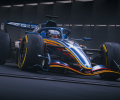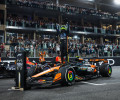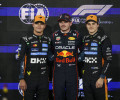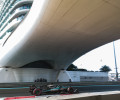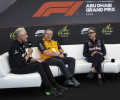2013 Hungarian Grand Prix - Preview
23.07.13
FIA Preview of the 2013 Hungarian Grand Prix.

|
|
|
|
|
Race Preview |
||
|
2013 HUNGARIAN GRAND PRIX 26 – 28 JULY 2013 |
||
|
Round 10 of the 2013 FIA Formula One World Championship – the final race before the sport’s traditional summer break – sees the teams preparing to do battle around the tight and twisting Hungaroring, home of the Hungarian Grand Prix. The race has been an ever-present on the calendar since 1986 and ranks third on the list of circuits to host the most consecutive F1 World Championship races, beaten only by Monaco (59) and Monza (32). With 14 corners and just one real straight,the Hungaroring presents teams with a similarproblem to that encountered in Monaco – how to maximise high downforce performance. Optimum aerodynamic grip will be the provenance of the teams but mechanical grip will largely come from a new range of Pirelli tyres. The manufacturer has altered its tyres for the rest of the season and will this weekend debut new tyres based on 2012 constructions and 2013 compounds. Here, teams will have a choice of Soft and Medium compounds. In the Drivers’ Championship, current leader Sebastian Vettel will have a chance to edge closer to a full set of current GP wins. A first home win at the Nürburgring three weeks ago leaves the German with just two winners’ trophies to claim (here and the US) but victory at the Hungaroring has proved elusive, with second in 2011 his best result. The form driver here is Mercedes’ Lewis Hamilton, who with three wins (2007, ’09, ’12), is just one shy of matching Michael Schumacher’s Hungaroring win record. In the Constructors’ battle, Red Bull Racing lead Mercedes by a healthy 67-point margin, with Ferrari third, just three points further back. |
 |
|
|
CIRCUIT DATA Hungaroring Length of lap: 4.381km Lap record: 1:19.071 (Michael Schumacher, Ferrari, 2004) Start line/finish line offset: 0.040km Total number of race laps: 70 Total race distance: 306.630km Pitlane speed limits: 80km/h throughout the entire event weekend. CHANGES TO THE CIRCUIT SINCE 2012 ► A new debris fence has been installed, on the left behind the guardrail on the pit straight. ► The kerbs at the exit of Turns 3, 8 and 9 have been provided with a drainage system for water that may accumulate in surface depressions. DRS ZONES ► There will be a two DRS zones in Hungary, with one detection point. The detection point will be after Turn 13. The first activation point will be after Turn 14, before the start/finish line. The second activation point will be just after Turn 1. |
||
|
|
||
 |
||
|
|
||
|
Hungarian GP Fast Facts |
||
|
► The Hungaroring has featured on the F1 calendar since 1986. This will be the 28th edition of the race. ► Michael Schumacher has won the race more times than any other driver, with four victories to his credit. Ayrton Senna is next on the list with three wins, a total matched by current Mercedes driver Lewis Hamilton. ► McLaren are the most successful team here with 11 victories. They are followed by Williams with seven wins and Ferrari with five. ► The Hungaroring was the scene of Fernando Alonso’s first grand prix win, in 2003. At the time, it made the Spaniard F1’s youngest winner, at 22 years and 26 days. Sebastian Vettel beat his record five years later. The German was just 21 years and 73 days old when he won the 2008 Italian GP for Toro Rosso. |
► Robert Kubica also made his Formula One debut at the Hungaroring, in 2006, racing for BMW-Sauber. He finished seventh and claimed two points, but was later disqualified when his car was found to be 2kg underweight. The Polish driver did not have too long to wait to register points, however. Two months later he took third place in Monza, the first of 12 podium finishes to date (including one victory, in Canada in 2008). ► Jenson Button’s march to his first win from 14th on grid at the rain-hit 2006 race represents the biggest climb from starting position to top step of the podium. Button is followed in that regard by Nigel Mansell, who scored victory from 12th on the grid in 1989. The two Britons are the only drivers in the history of the race to win from beyond the first two rows of the grid. ► Damon Hill also scored his maiden win in Hungary, racing for Williams in 1993. He was the first son of a world champion to win a grand prix. He went on to take 21 further wins and the 1996 title. The 1993 race also saw Riccardo Patrese score the final podium finish of his 257-race career. |
► Lewis Hamilton’s 2009 win for McLaren was the first F1 victory for a car equipped with a Kinetic Energy Recovery System (KERS). ► The F1 Drivers’ Championship has twice been won at the Hungaroring. Mansell, driving for Williams, won the 1992 championship at the Hungarian GP, the 11th race of a 16-race season, while Michael Schumacher won his fourth world title here in 2001 at the 13th race of a 17-race season. ► Zsolt Baumgartner became the first Hungarian to race in Formula One when he took part in his home race for Jordan in the 2003. Baumgartner replaced Jordan regular Ralph Firman, who had crashed heavily in practice. Baumgartner qualified 19th and his race lasted 34 laps before an engine failure ended his debut. He raced again for Jordan three weeks later in Italy and then completed a full season for Minardi in 2004. ► Despite the Hungaroring being a tough track on which to overtake, pole position isn’t crucial. Since 2005, the man starting at the front has won just twice – Hamilton, in ’07 and ’12. |
|
|
||
|
Hungarian GP Race Stewards Biographies |
||
|
GARRY CONNELLY DEPUTY PRESIDENT, FIA INSTITUTE; DIRECTOR, AUSTRALIAN INSTITUTE OF MOTOR SPORT SAFETY; F1 AND WTCC STEWARD; FIA WORLD MOTOR SPORT COUNCIL MEMBER |
 |
|
| Garry Connelly has been involved in motor sport since the late 1960s. A long-time rally competitor, Connelly was instrumental in bringing the World Rally Championship to Australia in 1988 and served as Chairman of the Organising Committee, Board member and Clerk of Course of Rally Australia until December 2002. He has been an FIA Steward and FIA Observer since 1989, covering the FIA’s World Rally Championship, World Touring Car Championship and Formula One Championship. He is a director of the Australian Institute of Motor Sport Safety and a member of the FIA World Motor Sport Council. | ||
|
|
||
|
JOSE ABED FIA VICE PRESIDENT |
 |
|
| José Abed, an FIA Vice President since 2006, began competing in motor sport in 1961. In 1985, as a motor sport official, Abed founded the Mexican Organisation of International Motor Sport (OMDAI) which represents Mexico in the FIA. He sat as its Vice- President from 1985 to 1999, becoming President in 2003. In 1986, Abed began promoting truck racing events in Mexico and from 1986 to 1992, he was President of Mexican Grand Prix organising committee. In 1990 and 1991, he was President of the organising committee for the International Championship of Prototype Cars and from 1990 to 1995, Abed was designated Steward for various international Grand Prix events. Since 1990, Abed has been involved in manufacturing prototype chassis, electric cars, rally cars and kart chassis. | ||
|
|
||
|
ALLAN MCNISH EX-FORMULA ONE RACER, LE MANS WINNER AND FIA WORLD ENDURANCE CHAMPIONSHIP DRIVER |
 |
|
| With three Le Mans wins, four Sebring 12-Hour victories and three ALMS titles to his credit, Allan McNish has carved out a reputation as one of the world’s top sportscar racers. However, he began his career in single seaters, racing in Formula Vauxhall, British F3, and International F3000 before landing a seat with the Toyota F1 team for its debut season in 2002. At the end of 2002 he parted company with Toyota and became a test driver for Renault. He then returned to sportscars where he once again built a hugely successful career. This year he is again racing in the FIA World Endurance Championship and after wins at the 6 Hours of Silverstone and at Le Mans he currently leads the series alongside team-mates Tom Kristensen and Loïc Duval. | ||
|
|
||
|
Hungarian GP Championship Standings (Drivers) |
||
 |
||
|
|
||
|
Hungarian GP Championship Standings (Constructors) |
||
 |
||
|
|
||
|
Hungarian GP Formula One Timetable & FIA Media Schedule |
||
|
|
||
|
THURSDAY Press Conference FRIDAY Practice Session 1 Practice Session 2 Press Conference SATURDAY Practice Session 3 Qualifying Followed by unilateral and press conference SUNDAY Drivers' Parade Race Followed by podium interviews and press conference |
15.00 10.00-11.30 14.00-15.30 16.00 11.00-12.00 14.00-15.00 12.30 14.00 |
|
|
|
||
| ADDITIONAL MEDIA OPPORTUNITIES | ||
|
QUALIFYING All drivers eliminated in Q1 or Q2 are available for media interviews immediately after the end of each session, as are drivers who participated in Q3, but who are not required for the post-qualifying press conference. The interview pen will be located in front of the entrance to the media centre. RACE Any driver retiring before the end of the race will be made available at each team’s garage/hospitality. In addition, during the race every team will make available at least one senior spokesperson for interview by officially accredited TV crews. A list of those nominated will be made available in the media centre. |
||

 Facebook
Facebook Twitter
Twitter